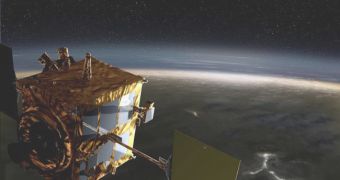At precisely 5:44 pm EDT (2044 GMT) today, the Japanese Aerospace Exploration Agency (JAXA) will launch its new Venus mission. The effort, which is scheduled to last for about two years, will see the Akatsuki Venus Climate Orbiter soaring to the skies alongside the Ikaros solar sail technology demonstrator. This is one of the most ambitious missions JAXA has undertaken thus far, and, if successful, it will prove the agency's capabilities to the world. The two spacecraft will take off from the Tanegashima Space Center, aboard an H-2A delivery system, Space reports.
“Once we can explain the structure of Venus, we will be able to better understand Earth. For example, we may discover the reasons that only Earth has been able to sustain oceans, and why only Earth is abundant in life. [Akatsuki is] the world's first interplanetary probe that deserves to be called a meteorological satellite,” said in a recent statement Takeshi Imamura, who is a JAXA Akatsuki project scientist. The name of the space probe means “Dawn” in Japanese. There are numerous aspects of Venus that the instruments on the satellite will survey, including clouds, volcanoes, the atmosphere, the geology and so on.
“Venus somehow transformed from a more Earth-like place to the alien place it is today, and what's fascinating about the world is figuring out how it diverges from the Earth and the history behind why that happened. It could help us understand how things here might change,” adds Denver Museum of Nature and Science curator of astrobiology David Grinspoon. He is also a Venus Express mission interdisciplinary scientist. This particular mission is being conducted by the European Space Agency (ESA). With the addition of Akatsuki, scientists will have two spacecrafts available for conducting science, and this will provide an additional mechanism for data cross-verification.
One of the greatest mysteries related to the Venusian atmosphere is the presence of lightning in its clouds. “What creates lightning on Earth is water droplets and ice crystals in clouds, which leads to the separation of electric charges that lightning needs, and you don't have that kind of weather on Venus. Maybe there's a kind of weather we haven't seen yet on Venus that causes this lightning, or maybe how we're wrong about the kinds of conditions needed to make lightning,” the expert says, adding that most of the planet's atmosphere is in fact made up of sulfuric acid. “Venus Express and Akatsuki are like sister satellites, and a very good cooperative relationship has been built as we have progressed in our missions,” Imamumra concluded.
“If there's one thing we've been learning about Venus, it's that it's a really dynamic planet that's very changeable, so we need as much long-term data as we can to build up an understanding of how things change over time. Having Akatsuki there should help capture more vital clues to understanding Venus's mysteries,” Grinspoon adds.

 14 DAY TRIAL //
14 DAY TRIAL //